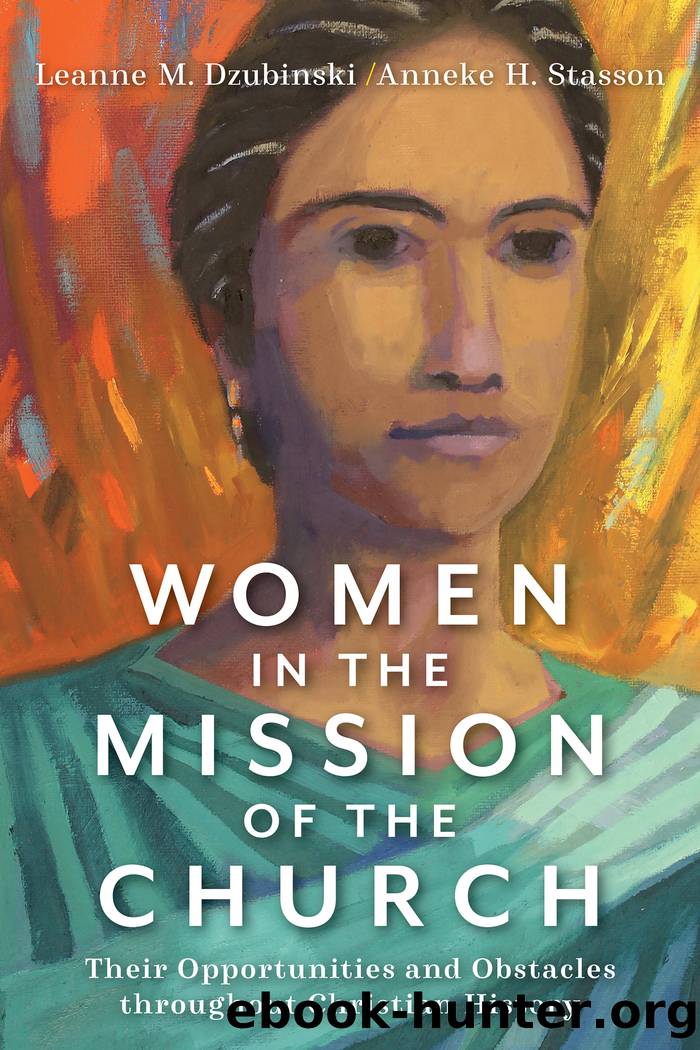Women in the Mission of the Church by Leanne M. Dzubinski

Author:Leanne M. Dzubinski
Language: eng
Format: epub
Tags: Missions/Church History;Women in Christianity—History;Women in church work—History;Mission of the church—History;REL045000;REL108020;REL109000
ISBN: 9781493429189
Publisher: Baker Publishing Group
Published: 2021-03-18T00:00:00+00:00
Conclusion
During the thirteenth century, there was a great flourishing of options for religious life, and women found many new opportunities for religious leadership. A central concern of church reformers in the Middle Ages was imitating Christ and living like the apostles. Many in the womenâs religious movement embraced this vita apostolica. They gave away their personal belongings and took up a life of serving sick people and those with leprosy. âWhatever you do for the least of these, you do for meâ was constantly on their lips. However, some priests and monks were uncomfortable with beguines and other women religious wandering around town outside a convent, so claustration was increasingly enforced in the thirteenth century. Beguines in Belgium retained their freedom, but other women throughout Europe were integrated into established religious orders. For some women, this severely hampered their ability to pursue the mission they believed God had called them to. Moreover, with the growing emphasis on the priesthood and the rise of the Franciscan friars, some women religious saw their own prestige and authority in society wane.
Even though claustration made some previous forms of mission impossible, women found new ways of devoting themselves to God and serving their neighbor. Some began to see food as a way to honor their call to poverty. They fasted, gave away their food, and developed even deeper dependence on the spiritual food of the Eucharist. Some women began to have visions and to write about these visions, often in their mother tongue rather than in Latin. Their writings formed some of the first vernacular literature in their regions. Priests who served them shared their visionary writings with others, promoting them as a way of encouraging the faithful.
Mysticism in this period was a predominantly female phenomenon and became an important avenue for womenâs religious leadership. It enabled women to serve as counselors, teachers, mediators, and theologians. Moreover, the theological shift in emphasis from Christâs kingship to his bodily humanity was stimulated in large part by womenâs visions of the Eucharist, the Christ child, and the man Jesus.
Download
This site does not store any files on its server. We only index and link to content provided by other sites. Please contact the content providers to delete copyright contents if any and email us, we'll remove relevant links or contents immediately.
| Adult Ministry | Children's Ministry |
| Counseling & Recovery | Discipleship |
| Evangelism | Missions & Missionary Work |
| Preaching | Sermons |
| Youth Ministry |
Victory over the Darkness by Neil T. Anderson(2820)
The Rape Of Nanking by Iris Chang(2777)
Chosen by God by R. C. Sproul(2123)
Habits of Grace by David Mathis(1947)
Crash the Chatterbox by Steven Furtick(1942)
Knowing God by J.I. Packer(1807)
How To Be Born Again by Billy Graham(1732)
A Prophet with Honor by William C. Martin(1685)
Gospel-Shaped Marriage by Chad van Dixhoorn(1684)
Peace with God by Billy Graham(1643)
Confronting Christianity by Rebecca McLaughlin(1558)
God's Smuggler by Brother Andrew(1512)
Angel Dreams by Virtue Doreen Virtue Melissa(1448)
Whisper by Mark Batterson(1424)
Missionaries by Norman Lewis(1395)
The School of Biblical Evangelism by Ray Comfort(1392)
The Truth War by John MacArthur(1387)
The Poems of Rowan Williams by Rowan Williams(1324)
Do Greater Things by Robby Dawkins(1295)
